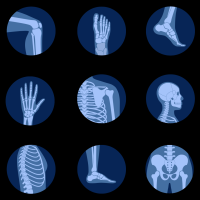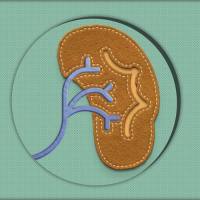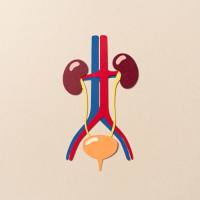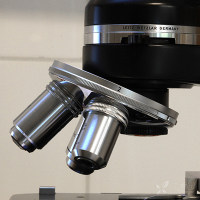《Nature Genetics》:一种新的前列腺癌抑制基因被发现
尽管先前的研究显示16号染色体的一段含有一种与若干人类癌症有关的肿瘤抑制基因,但一直未能找出这个基因。现在,埃默里的研究人员通过分析16号染色体的这个片断,发现ATBF1是这种肿瘤抑制基因的最有可能的候选。这是因为在因基因突变或/和表达缺失造成的前列腺癌中,这种基因往往发生了缺失。另外,ATBF1还能抑制培养基中的细胞生长(注:所谓肿瘤抑制基因就是在功能缺失时会导致癌症发生的基因)。
ATBF1是一种转录因子,如果其功能受突变或表达缺失的影响,细胞就会丧失对癌基因的控制。由于ATBF1能抑制细胞的扩增,因此能抑制这种基因的获得性突变将导致前列腺癌细胞的生长失控。
散发性癌症通常是由于多个遗传突变经过长时间积累导致的,但只有少数基因会发生这些突变。因为ATBF1抑制细胞扩增,所以常发生的抑制这种基因的突变可能导致前列腺癌的失控生长。又因为16号染色体的基因缺失在多种类型的癌症中很常见(包括肺癌、头颈癌、鼻咽癌、乳腺癌和卵巢癌),因此ATBF1可能与这些癌症的发生有关。
这些发现公布在3月6日的Nature Genetics的网络版上。
Nature Genetics 37, 407 - 412 (2005)
Published online: 6 March 2005; | doi:10.1038/ng1528
Frequent somatic mutations of the transcription factor ATBF1 in human prostate cancer
Xiaodong Sun1, Henry F Frierson2, 10, Ceshi Chen1, 10, Changling Li3, Qimei Ran1, Kristen B Otto1, Brandi M Cantarel4, Robert L Vessella5, Allen C Gao6, John Petros7, Yutaka Miura8, Jonathan W Simons1 & Jin-Tang Dong1, 9
1 Winship Cancer Institute, Department of Hematology and Oncology, Emory University School of Medicine, Atlanta, Georgia 30322, USA.
2 Department of Pathology, University of Virginia Health System, Charlottesville, Virginia 22901, USA.
3 Department of Urological Oncology, Cancer Institute (Hospital), Chinese Academy of Medical Sciences, Beijing 100021, China.
4 Department of Biochemistry and Molecular Genetics, University of Virginia Health System, Charlottesville, Virginia 22901, USA.
5 Department of Urology, University of Washington Medical Center, Seattle, Washington 98195, USA.
6 Departments of Medicine and Pharmacology, Roswell Park Cancer Institute, Buffalo, New York 14263, USA.
7 Departments of Urology and Pathology, Emory University School of Medicine, Atlanta, Georgia 30322, USA.
8 Department of Molecular Neurobiology, Nagoya City University Graduate School of Medical Sciences, Nagoya, 467-8601, Japan.
9 Department of Urology and Program in Genetics and Molecular Biology, Emory University School of Medicine, Atlanta, Georgia 30322, USA.
10 These authors contributed equally to this work.
Correspondence should be addressed to Jin-Tang Dong jdong2@emory.edu
Cancer often results from the accumulation of multiple genetic alterations. Although most malignancies are sporadic, only a small number of genes have been shown to undergo frequent mutations in sporadic cancers. The long arm of chromosome 16 is frequently deleted in human cancers, but the target gene for this deletion has not been identified1, 2, 3, 4. Here we report that ATBF1, which encodes a transcription factor that negatively regulates AFP and MYB5, 6 but transactivates CDKN1A7, is a good candidate for the 16q22 tumor-suppressor gene. We narrowed the region of deletion at 16q22 to 861 kb containing ATBF1. ATBF1 mRNA was abundant in normal prostates but more scarce in approximately half of prostate cancers tested. In 24 of 66 (36%) cancers examined, we identified 22 unique somatic mutations, many of which impair ATBF1 function. Furthermore, ATBF1 inhibited cell proliferation. Hence, loss of ATBF1 is one mechanism that defines the absence of growth control in prostate cancer.
We first carried out deletion mapping to localize the 16q22 tumor-suppressor gene in prostate cancer. Using 19 xenografts or cell lines, we detected three regions of loss of heterozygosity (LOH; Fig. 1a), which occurred at a frequency of 35−40% and overlapped with previously identified regions2, 8. For LOH at 16q22, we examined nine additional xenografts, and the final frequency was 39% (11 of 28, including NCI-H660, PC-3, CWR91, LAPC3, LuCaP 35, LuCaP 70, LuCaP 77, LuCaP 86, LuCaP 92, LuCaP 93, LuCaP 96 and case 32). We detected a 1.2-Mb region of homozygous deletion in CWR91 xenograft (Fig. 1b,c), which was further narrowed to 861 kb on the basis of hemizygous deletions in three samples (Fig. 1b,c).
Figure 1. Deletion mapping of the 16q22 locus in prostate cancer.
(a) Detection of three regions of LOH, indicated at the left, in xenografts and cell lines from individuals with prostate cancer. Only cases with LOH are shown. The region of deletion in each case is indicated by a vertical line. Open and filled circles indicate heterozygosity and homozygosity, respectively. (b) Detection of homozygous (left) and hemizygous deletion (right) at 16q22 by duplex PCR analysis. Deletion status for each marker is indicated in c. HP, normal human placenta. (c) Identification of the smallest region of deletion at 16q22. Marker names are at the top, case names are at the left, and the common region of deletion is indicated by a thick line. Open circles, homozygous deletion; -, hemizygous deletion; +, nondeletion. The location of ATBF1 is also marked.
Full Figure and legend (60K)
The 861-kb region of deletion contains the gene ATBF1, several Unigene clusters and some hypothetical genes. ATBF1 is a plausible candidate for further analysis because it is an AT-motif binding transcription factor9 that negatively regulates AFP and MYB5, 6 but transactivates CDKN1A7 and because it is not expressed in gastric cancers10. RT-PCR analyses showed a high level of ATBF1 expression in normal prostates but reduced expression in some prostate cancer cell lines and each immortalized non-neoplastic prostatic epithelial cell line (Fig. 2a). We also detected loss of ATBF1 expression in cancer cells in northern-blot analysis (Fig. 2b), in which we detected two splicing variants of ATBF1 (A or B)11. By using real-time PCR, we found that 9 of 15 cancer samples expressed ATBF1 at a level less than 50% of that in normal prostates (Fig. 2c).
Figure 2. Reduced expression of ATBF1 in prostatic cancer cells.
(a) Duplex RT-PCR analysis. (b) Northern-blot analysis. (c) Real-time PCR assay. Expression of ATBF1 in each sample is indicated by its ratio to that of the normal.
Full Figure and legend (29K)
To test further whether ATBF1 is the 16q22 tumor-suppressor gene, we carried out PCR−single-strand conformation polymorphism (SSCP) analysis in combination with DNA sequencing to detect ATBF1 mutations (Fig. 3 and Supplementary Fig. 1 online). For 44 samples including 6 cell lines, 22 xenografts and 16 grossly dissected fresh primary tumors, we used 44 pairs of PCR primers to amplify nine of the ten exons of ATBF1 from genomic DNA. For 26 manually microdissected high-grade tumors and metastases, we used 83 pairs of primers to amplify ATBF1 from exon 3 to exon 9 (60% of the coding region). In total, we detected 5, 9 and 21 mutations in 4 of 16 (25%) low- to mid-grade primary tumors, 8 of 26 (31%) high-grade tumors and 12 of 28 (43%) xenografts or cell lines, respectively (Table 1 and Fig. 3). Twenty-two mutations were unique (Table 1).
Figure 3. Detection of ATBF1 mutations in prostate cancer samples by PCR-SSCP analysis.
(a) Representative examples of bandshifts for point mutations and small deletions in cancer samples. (b) Examples of SSCP bandshifts for the 21- to 24-nucleotide deletion. Arrows indicate the two extra bands in the tumor cells of case 31. N, normal; T, tumor. (c) Examples of bandshifts for microdissected tumors. (a,c) Primer pairs are listed underneath gel panels, and arrows indicate the shifted bands.
Full Figure and legend (44K)
Table 1. Summary of ATBF1 mutations in prostate cancer
Full Table
Among the mutations, eight frameshifting deletions and one nonsense mutation occurred in 6 of the 66 (9%) cancers (Table 1). These mutations disrupt the structure of ATBF1 protein. For example, the 2174G T nonsense mutation in the LuCaP 23 xenograft removed 22 zinc-finger domains and all 4 homeodomains of ATBF1. Some of these domains are essential for ATBF1 in DNA binding12. We noticed that each of the mono- or dinucleotide deletions occurred in repetitive sequences (Table 1). Such deletions are often related to microsatellite instability caused by mismatch-repair deficiency13 and therefore may not be relevant to carcinogenesis. To rule out this possibility, we selected 16 DNA segments containing G7/C7 sequences from introns of genes surrounding ATBF1 at 16q22 and determined whether the number of repetitive G/C bases changed in the three samples that had mono- or dinucleotide deletions of ATBF1. We detected no deletions or insertions in any of the three samples (Supplementary Table 1 online). In total, only one of eight tested samples had a change in 1 of 16 sequences, which represents an incidence of 1 in 128 (0.8%) sample-markers. Similar changes in ATBF1 occurred five times for four G/C tracts in the same eight samples, which represents an incidence of 5 in 32 (16%) sample-markers. Three of the sixteen markers showed frequent length variation among both cancer samples and a group of DNA samples from healthy individuals (Supplementary Table 1 online) and are therefore considered to be germline polymorphisms. Therefore, although microsatellite instability may have occurred in some tumors, the deletions in ATBF1 are more likely causal mutations involved in prostate cancer.
In 8 of 66 (12%) cases, the mutations seemed to disrupt normal splicing of ATBF1 (Table 1). Except for the T C mutation at the splicing donor site of intron 2 in case 39, four cell lines and three xenografts had shorter polypyrimidine tracts in intron 8 near its 3' splice site. The polypyrimidine tract is a cis element that directs intron removal in pre-mRNA splicing, and progressive deletions of the tract can abolish correct splicing14. We therefore tested whether the deletions had any effect on splicing of ATBF1. The ratios of aberrant transcript to normal transcript were significantly higher in the samples with deletions than in those without a deletion (Fig. 4). Aberrant or truncated transcripts are often unstable and are degraded rapidly. Consistent with this notion, 22Rv1 cells, which have the shortest polypyrimidine tract, expressed less ATBF1 than did LNCaP and PC-3 cells, which have a longer tract (Fig. 2). We noticed that 67% (4 of 6) cancer cell lines but only 14% (3 of 22) xenografts and none of the clinical tumors had a deletion in the polypyrimidine tract (Table 1).
Figure 4. Aberrant splicing of ATBF1 in cell lines with deletions in the polypyrimidine tract in intron 8.
(a) Schematic representation of the genomic sequence of ATBF1 indicating the locations of exons 8−10 (open boxes), the polypyrimidine tract (Tn) and the primers (P8, P9 and P10). Solid and dashed lines indicate normal and abnormal splicing, respectively. (b) Detection of normal and aberrant transcripts by RT-PCR. Shown below the gel picture are the lengths of polypyrimidine tract (Ts) and the ratios of aberrant transcript to normal transcript for each sample.
Full Figure and legend (13K)
In 9 of the 66 (14%) cases, we detected a deletion of 21 or 24 nucleotides in exon 10. The deletion was somatic in some cases (cases 26, 31 and 52M3) but also occurred in the germ line (cases 27, 39 and 51M; Fig. 3b and Table 1). The deletion is tumor-associated, because it was detected in 9 of 66 (14%) tumors or individuals with prostate cancer but none of 104 (0%) individuals without neoplasms (data not shown). These deletions remove 7−8 amino acids starting from codon 3381 in a glutamine/proline-rich domain of ATBF1. Such domains are common transactivation domains15, and their mutation often impairs a transcription factor's function16, 17.
Of the seven point mutations that we detected, four were somatic, as they were detected in tumors but not in matched normal controls. Three mutations occurred in cell lines and xenografts but were not detected in 42 DNA samples from unrelated healthy individuals (data not shown). A trinucleotide polymorphism also occurred somatically in cases 49T and 105T (Table 1). It remains to be determined whether these changes are benign polymorphisms or disease-causing mutations. Furthermore, we detected 25 sequence alterations considered to be SNPs and three polymorphic trinucleotide-repeat sequences (Supplementary Table 2 online). These findings suggest that ATBF1 is highly susceptible to genetic alteration that may lead to frequent mutations during prostatic carcinogenesis.
Seven cases had two to five mutations in ATBF1 (Table 1). If different mutations occurred in different alleles, there would be a complete lack of normal gene product for ATBF1. Although many of the mutations were heterozygous, they could still have a functional impact, because tumor-suppressor genes such as PTEN are often haploinsufficient18. The same mutations were detected in 22Rv1 cells and xenograft CWR22 (the former was derived from the latter). Similarly, xenografts LuCaP 23.1 and LuCaP 23.8, which were derived from different tumors of the same individual, also shared the same mutation. Therefore, it is less likely that some of the mutations were generated during the growth of cells or xenografts in culture.
The frequency of ATBF1 mutation was 43% (12 of 28) in xenografts and cell lines, 36% (8 of 22) in microdissected high-grade tumors and 25% (4 of 16) in low- to mid-grade primary tumors. Several factors could be responsible for the lower rate of mutation in low- to mid-grade tumors, including tissue preparation by gross dissection rather than microdissection, the heterogeneous nature of prostate cancer and a possible association of ATBF1 mutation with the aggressiveness of prostate cancer. The latter is consistent with the finding that deletion at 16q is more frequent in cancers with higher tumor stage, higher tumor grade or metastasis2, 19, 20.
Functionally, ATBF1 suppressed cell proliferation. In an ATBF1-positive cell line (PC-3), introduction of short interfering RNA (siRNA) for ATBF1 substantially reduced ATBF1 expression and increased cell proliferation (Fig. 5a,b). On the other hand, re-expression of ATBF1 in an ATBF1-negative cell line (22Rv1) decreased colony-forming efficiency (Fig. 5c,d). These results further implicate ATBF1 in prostate cancer.
Figure 5. Suppression of cell proliferation by ATBF1.
(a) RNA interference−mediated loss of function for ATBF1-enhanced cell proliferation in PC-3 cells. The y axis shows optical density, representing cell number. Luc, luciferase. *P < 0.05; **P < 0.005. (b) Reduced ATBF1 expression by siRNA transfection in PC-3 cells, as detected by real-time PCR assay. Luc, luciferase. (c) Re-expression of ATBF1 decreased colony formation in 22Rv1 cells. Shown are cells from day 12 after transfection. Wells in the upper row were transfected with ATBF1; wells in the lower row are controls. (d) Estimation of cell numbers by sulforhodamine B staining for ATBF1-transfected cells. The y axis shows optical density, representing cell number. *P < 0.005.
Full Figure and legend (33K)
ATBF1 is an AT-rich motif binding transcription factor9. It has two isoforms, ATBF1-A and ATBF1-B; the A form encodes a protein of 3,703 amino acids with 23 zinc-finger domains, 4 homeodomains and a number of other domains11. ATBF1 negatively regulates AFP in hepatoma cells5, 9, is absent in AFP-producing gastric cancer10, interacts with MYB in vitro to inhibit its transcriptional activity6 and transactivates the CDKN1A cyclin-dependent kinase inhibitor7. It also has a role in neuronal differentiation21, 22. These findings are consistent with the concept that ATBF1 is a tumor-suppressor gene.
In summary, we narrowed a region of deletion at 16q22, identified frequent mutations in ATBF1 in prostate cancer, especially with higher tumor grades, and demonstrated an inhibitory function for ATBF1 in cell proliferation. These findings suggest that ATBF1 has a tumor-suppressive role in prostate cancer. ATBF1 may also be involved in the development of other cancers, because deletion of 16q is common in many types of carcinomas, including those of the lung, head and neck, nasopharynx, stomach, breast and ovary1.
Methods
Cell lines, xenografts and tissue specimens.
We used six prostate cancer cell lines (DU 145, NCI-H660, LNCaP, 22Rv1, MDAPCa2b and PC-3) and four immortalized untransformed prostatic epithelial cell lines (BRF-55T, PZ-HPV7, PWR1E and RWPE1). We purchased BRF-55T from Biological Research Faculty & Facility and the others from American Type Culture Collection. We propagated cells in accordance with the manufacturer's instructions. We also analyzed 22 xenografts established from prostate cancers (CWR21, CWR91, LAPC3, LAPC4, LAPC9, PC82, LuCaP 23, LuCaP 35, LuCaP 41, LuCaP 49, LuCaP 58, LuCaP 69, LuCaP 70, LuCaP 73, LuCaP 77, LuCaP 81, LuCaP 86, LuCaP 92, LuCaP 93, LuCaP 96, LuCaP 105 and LuCaP 115), most of which were described in detail in our previous study23. We also used 16 frozen fresh prostate cancer specimens for the detection of mutation and deletion. For these cases, we extracted genomic DNA from pairs of grossly dissected normal and tumor tissues. We also screened for mutations in ATBF1 in tumor cells manually microdissected from 26 high-grade tumors (Gleason score of 8 or above) or metastases of prostate cancer from 22 individuals. Finally, we used genomic DNA from 104 unrelated individuals to evaluate the sequence alterations that were not frameshifting. We isolated genomic DNA and cytoplasmic RNA using standard procedures for fresh tissues and xenografts or cell lines or the procedures from our previous study24 for cells microdissected from fixed tissue sections. Use of human materials in this study was approved by the Institutional Review Board at Emory University (protocol identification number 534-2002).
Detection of LOH, homozygous deletion and hemizygous deletion.
We used 24 well-mapped microsatellite markers spanning chromosome 16q13−q24 to detect LOH by the homozygosity mapping-of-deletion analysis25, 26. To detect homozygous deletion and hemizygous deletion, we carried out duplex PCR, as described in our previous study25. We considered a deletion to be present when the ratio of a 16q22 marker to a control marker in a tumor sample was less than half of that in normal human placental DNA.
Expression analysis.
We synthesized first-strand cDNA from total RNA using the Superscript cDNA synthesis system (Invitrogen) with random primers. We used an RNA pool of 19 normal human prostates (Clontech) as the normal control. We quantified expression of ATBF1 in prostate cancer cell lines and xenografts by real-time PCR with the ABI SYBR Green Kit and the ABI Prism 7000 Sequence Detection System (Applied Biosystems). We designed primers using Primer Express software (Applied Biosystems). Primer sequences are available on request. Using the standard curve method, we calculated the expression level of ATBF1 in each sample calculated and expressed it as a ratio to the gene -actin (ACTB). The expression for each sample was normalized against that of the normal sample (defined as 1).
For northern-blot analysis, we generated a probe by amplifying a 1,291-bp DNA of ATBF1 (primer sequences available on request) from a cDNA sample of normal human prostate. We purified the PCR products with the PCR Purification Kit (Qiagen) and radiolabeled them using the Random Primers DNA Labeling System (Invitrogen). We separated 15 g of total RNA for each sample in a 1% formaldehyde-agarose gel, transferred it to membrane and hybridized it in QuikHyb Hybridization Solution (Stratagene) using a standard protocol. We visualized hybridization signals by autoradiography. The same membrane was stripped and hybridized with an ACTB probe as a loading control27. Primer sequences for duplex RT-PCR analysis are available on request.
Mutation analysis.
We designed 44 pairs of PCR primers to cover nine exons spanning the coding region of ATBF1. Each pair of primers amplifies a fragment of genomic DNA ranging from 200 to 500 bp, which covered the exon-intron junctions. To detect ATBF1 mutations in manually microdissected tumor cells from formalin-fixed, paraffin-embedded tissues, in which DNA is usually severely degraded, we designed an additional 83 pairs of primers that amplify 100−150 bp of DNA and span exons 3−9 of ATBF1. All primer sequences are available on request. With these PCR primers, we carried out SSCP analysis to detect gene mutations as previously described27, 28. For samples that showed a bandshift, which suggested the presence of a mutation, the PCR-SSCP process was repeated one or two times to confirm the shift. Once the same pattern of bandshift was detected in each of the repeats for a sample, the shifted band was cut and amplified by PCR using the same primers. We purified the resultant PCR products using the PCR Purification Kit (Qiagen) and subjected them to DNA sequence determination by a commercial vendor (LIFENHANCER). We compared DNA sequences with that of ATBF1 in GenBank using the DNA Star software to identify the sequence alterations. For each of the sequence alterations detected, we carried out another round of PCR on genomic DNA and then directly sequenced the PCR products to verify a sequence alteration. PCR products from some primer pairs showed a heterozygous genotype in some cases, and the band-cut procedure did not always work well in DNA sequence determination. When the band-cut procedure did not work, we cloned the PCR products into the pGEM-T vector (Promega) and isolated and sequenced plasmid DNA from two to four clones for each PCR reaction to determine the sequence alterations accurately.
For all the sequence alterations that were not nonsense or frameshifting mutations, we carried out PCR-SSCP analysis in DNA samples from 42 unrelated healthy individuals, with the sample that had bandshift as a control, to determine if such an alteration was a real mutation or a SNP. If the same alteration was also present in these healthy individuals at a similar frequency, it was defined as a SNP rather than a mutation.
Detection of exon skipping.
To determine whether deletions in the polypyrimidine tract in intron 8 affect ATBF1 splicing, we designed three primers (P8, P9 and P10) from exons 8, 9 and 10 of ATBF1, respectively (Fig. 4a). P8 and P9 amplify normally spliced ATBF1 transcripts, whereas P8 and P10 amplify ATBF1 transcripts with exon 9 skipping. Sequences of these primers are available on request. We used the RT-PCR approach as described above with all three primers in the same reaction tube to amplify ATBF1 from each of the cell lines (Fig. 4b). After capturing the gel image, we measured the intensity of each PCR product band with the ImageJ computer program and calculated the ratio of aberrant splicing product to normal product for each sample.
Detection of insertion or deletion in mononucleotide repeat track.
On the basis of the current human genomic sequences, we randomly chose 16 short mononucleotide tracts from introns of genes spaced between 0.4 Mb and 1 Mb at 16q22 (Supplementary Table 1 online). Primer sequences are available on request. We carried out PCR as described for the mutation detection assay in the presence of 32P-dCTP. We denatured PCR products, separated them on 6% denaturing polyacrylamide gels, dried the gels and subjected them to autoradiography. A bandshift indicates the presence of an insertion or deletion.
Cell proliferation assays.
We seeded the PC-3 prostate cancer cell line, one of the few prostatic epithelial cell lines expressing a higher level of ATBF1 (Fig. 2c), at 50,000 cells per well in 24-well tissue culture plates. After 16 h, we transfected the cells with siRNA of either ATBF1 or luciferase (as a negative control) using the siPORT Amine reagent from Ambion. The final concentration of siRNA was 200 nM for both genes. The siRNAs were provided by Dharmacon (sequences available on request). At 0−6 d after transfection, we collected cells in one well for RNA isolation and fixed cells in another three wells with 10% trichloroacetic acid. We stained fixed cells with sulforhodamine B and measured their optical densities using a published protocol29. Cell numbers were indicated by the optical densities. We determined the expression of ATBF1, and glyceraldehyde-3-phosphate dehydrogenase (GAPD) as a control, using the real-time PCR approach described above. PCR primer sequences are available on request. Statistical significance was determined by Student's t-test.
For colony-forming efficiency assay, we seeded the 22Rv1 prostate cancer cell line, which expresses little ATBF1 (Fig. 2c), into six-well tissue culture plates at 240,000 cells per well. We transfected the cells with 1 g of pcMATBF1w plasmid, which contains the human ATBF1-A coding region11 downstream of the cytomegalovirus promoter in the pcDNA1 vector (Invitrogen), and 0.04 g of pSIREN-LUCi, which contains the puromycin-resistance gene. We used the pBS19X13.6 plasmid, which contains 13.6 kb of intron sequence from the human KAI1 gene and is similar in size to pcMATBF1w, as a negative control for the transfection. We used the Lipofectamine plus reagent (Invitrogen) to transfect 22Rv1 cells with pcMATBF1w or the control plasmid with pSIREN-LUCi. Forty-eight hours after transfection, we added puromycin (final concentration of 2 g ml-1), which completely killed parental 22Rv1 cells in two weeks. Two weeks after selection in puromycin-containing medium, we stained cells with sulforhodamine B solution and measured them as described above. Each assay was repeated two or three times, and similar results were obtained each time. Statistical significance was determined by Student's t-test.
URL.
The ImageJ computer program is available at http://rsb.info.nih.gov/ij/.
GenBank accession number.
ATBF1-A mRNA sequence, NM_006885.
Note: Supplementary information is available on the Nature Genetics website.
Top
Received 1 November 2004; Accepted 14 January 2005; Published online: 6 March 2005.
REFERENCES
Knuutila, S. et al. DNA copy number losses in human neoplasms. Am. J. Pathol. 155, 683−694 (1999). | PubMed | ISI | ChemPort |
Dong, J.T. Chromosomal deletions and tumor suppressor genes in prostate cancer. Cancer Metastasis Rev. 20, 173−193 (2002). | Article |
Nelson, W.G., De Marzo, A.M. & Isaacs, W.B. Prostate cancer. N. Engl. J. Med. 349, 366−381 (2003). | Article | PubMed | ISI | ChemPort |
Albertson, D.G., Collins, C., McCormick, F. & Gray, J.W. Chromosome aberrations in solid tumors. Nat. Genet. 34, 369−376 (2003). | Article | PubMed | ISI | ChemPort |
Ninomiya, T. et al. Regulation of the alpha-fetoprotein gene by the isoforms of ATBF1 transcription factor in human hepatoma. Hepatology 35, 82−87 (2002). | Article | PubMed | ISI | ChemPort |
Kaspar, P. et al. Myb-interacting protein, ATBF1, represses transcriptional activity of Myb oncoprotein. J. Biol. Chem. 274, 14422−14428 (1999). | Article | PubMed | ISI | ChemPort |
Kataoka, H. et al. ING1 represses transcription by direct DNA binding and through effects on p53. Cancer Res. 63, 5785−5792 (2003). | PubMed | ChemPort |
Latil, A., Cussenot, O., Fournier, G., Driouch, K. & Lidereau, R. Loss of heterozygosity at chromosome 16q in prostate adenocarcinoma: identification of three independent regions. Cancer Res. 57, 1058−1062 (1997). | PubMed | ISI | ChemPort |
Morinaga, T., Yasuda, H., Hashimoto, T., Higashio, K. & Tamaoki, T. A human alpha-fetoprotein enhancer-binding protein, ATBF1, contains four homeodomains and seventeen zinc fingers. Mol. Cell. Biol. 11, 6041−6049 (1991). | PubMed | ISI | ChemPort |
Kataoka, H. et al. Alpha-fetoprotein producing gastric cancer lacks transcription factor ATBF1. Oncogene 20, 869−873 (2001). | Article | PubMed | ChemPort |
Miura, Y. et al. Cloning and characterization of an ATBF1 isoform that expresses in a neuronal differentiation-dependent manner. J. Biol. Chem. 270, 26840−26848 (1995). | Article | PubMed | ISI | ChemPort |
Kawaguchi, M. et al. DNA/RNA-dependent ATPase activity is associated with ATBF1, a multiple homeodomain-zinc finger protein. Biochim. Biophys. Acta 1550, 164−174 (2001). | PubMed | ChemPort |
Ionov, Y., Peinado, M.A., Malkhosyan, S., Shibata, D. & Perucho, M. Ubiquitous somatic mutations in simple repeated sequences reveal a new mechanism for colonic carcinogenesis. Nature 363, 558−561 (1993). | Article | PubMed | ISI | ChemPort |
Coolidge, C.J., Seely, R.J. & Patton, J.G. Functional analysis of the polypyrimidine tract in pre-mRNA splicing. Nucleic Acids Res. 25, 888−896 (1997). | Article | PubMed | ISI | ChemPort |
Remacle, J.E., Albrecht, G., Brys, R., Braus, G.H. & Huylebroeck, D. Three classes of mammalian transcription activation domain stimulate transcription in Schizosaccharomyces pombe. EMBO J. 16, 5722−5729 (1997). | Article | PubMed | ChemPort |
Takada, N., Ozaki, T., Ichimiya, S., Todo, S. & Nakagawara, A. Identification of a transactivation activity in the COOH-terminal region of p73 which is impaired in the naturally occurring mutants found in human neuroblastomas. Cancer Res. 59, 2810−2814 (1999). | PubMed | ISI | ChemPort |
Courey, A.J., Holtzman, D.A., Jackson, S.P. & Tjian, R. Synergistic activation by the glutamine-rich domains of human transcription factor Sp1. Cell 59, 827−836 (1989). | Article | PubMed | ISI | ChemPort |
Di Cristofano, A., Pesce, B., Cordon-Cardo, C. & Pandolfi, P.P. Pten is essential for embryonic development and tumour suppression. Nat. Genet. 19, 348−355 (1998). | Article | PubMed | ISI | ChemPort |
Strup, S.E. et al. Chromosome 16 allelic loss analysis of a large set of microdissected prostate carcinomas. J. Urol. 162, 590−594 (1999). | Article | PubMed | ISI | ChemPort |
Matsuyama, H. et al. Clinical significance of chromosome 8p, 10q, and 16q deletions in prostate cancer. Prostate 54, 103−111 (2003). | Article | PubMed | ChemPort |
Ido, A., Miura, Y. & Tamaoki, T. Activation of ATBF1, a multiple-homeodomain zinc-finger gene, during neuronal differentiation of murine embryonal carcinoma cells. Dev. Biol. 163, 184−187 (1994). | Article | PubMed | ChemPort |
Ishii, Y. et al. ATBF1-A protein, but not ATBF1-B, is preferentially expressed in developing rat brain. J. Comp. Neurol. 465, 57−71 (2003). | Article | PubMed | ChemPort |
Chen, C., Bhalala, H.V., Vessella, R.L. & Dong, J.T. KLF5 is frequently deleted and down-regulated but rarely mutated in prostate cancer. Prostate 55, 81−88 (2003). | Article | PubMed | ChemPort |
Dong, J.T., Chen, C., Stultz, B.G., Isaacs, J.T. & Frierson, H.F., Jr. Deletion at 13q21 is associated with aggressive prostate cancers. Cancer Res. 60, 3880−3883 (2000). | PubMed | ISI | ChemPort |
Chen, C. et al. An 800 kb region of deletion at 13q14 in human prostate and other carcinomas. Genomics 77, 135−144 (2001). | Article | PubMed | ChemPort |
Goldberg, E.K. et al. Localization of multiple melanoma tumor-suppressor genes on chromosome 11 by use of homozygosity mapping-of-deletions analysis. Am. J. Hum. Genet. 67, 417−431 (2000). | Article | PubMed | ChemPort |
Chen, C. et al. Deletion, mutation, and loss of expression of KLF6 in human prostate cancer. Am. J. Pathol. 162, 1349−1354 (2003). | PubMed | ISI | ChemPort |
Kukita, Y., Tahira, T., Sommer, S.S. & Hayashi, K. SSCP analysis of long DNA fragments in low pH gel. Hum. Mutat. 10, 400−407 (1997). | Article | PubMed | ISI | ChemPort |
Sun, S.Y. et al. Differential effects of synthetic nuclear retinoid receptor-selective retinoids on the growth of human non-small cell lung carcinoma cells. Cancer Res. 57, 4931−4939 (1997). | PubMed | ChemPort |
Top















































